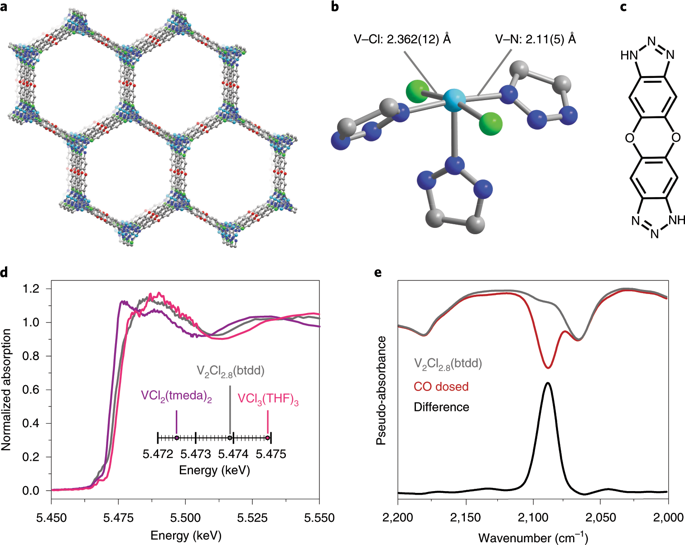Nature Materials ( IF 37.2 ) Pub Date : 2020-02-03 , DOI: 10.1038/s41563-019-0597-8 David E Jaramillo 1 , Douglas A Reed 1 , Henry Z H Jiang 1 , Julia Oktawiec 1 , Michael W Mara 1 , Alexander C Forse 1, 2, 3 , Daniel J Lussier 1, 4 , Ryan A Murphy 1 , Marc Cunningham 3 , Valentina Colombo 5 , David K Shuh 4 , Jeffrey A Reimer 3, 6 , Jeffrey R Long 1, 3, 6

|
Industrial processes prominently feature π-acidic gases, and an adsorbent capable of selectively interacting with these molecules could enable important chemical separations1,2,3,4. Biological systems use accessible, reducing metal centres to bind and activate weakly π-acidic species, such as N2, through backbonding interactions5,6,7, and incorporating analogous moieties into a porous material should give rise to a similar adsorption mechanism for these gaseous substrates8. Here, we report a metal–organic framework featuring exposed vanadium(ii) centres capable of back-donating electron density to weak π acids to successfully target π acidity for separation applications. This adsorption mechanism, together with a high concentration of available adsorption sites, results in record N2 capacities and selectivities for the removal of N2 from mixtures with CH4, while further enabling olefin/paraffin separations at elevated temperatures. Ultimately, incorporating such π-basic metal centres into porous materials offers a handle for capturing and activating key molecular species within next-generation adsorbents.
中文翻译:

通过在具有暴露钒位点的金属有机框架中的背键选择性吸附氮
工业过程的突出特点是 π 酸性气体,能够选择性地与这些分子相互作用的吸附剂可以实现重要的化学分离1,2,3,4。生物系统使用可接近的还原金属中心通过回键相互作用5,6,7结合和激活弱 π-酸性物质,例如 N 2 ,并且将类似的部分结合到多孔材料中应该会产生类似的吸附机制气态底物8.在这里,我们报告了一种具有暴露钒(ii) 中心能够将电子密度回馈给弱 π 酸,从而成功地针对 π 酸度进行分离应用。这种吸附机制,连同高浓度的可用吸附位点,导致了从与 CH 4的混合物中去除 N 2的创纪录的 N 2容量和选择性,同时进一步实现了在高温下烯烃/链烷烃的分离。最终,将这种 π 碱性金属中心结合到多孔材料中,为捕获和激活下一代吸附剂中的关键分子物种提供了一种手段。











































 京公网安备 11010802027423号
京公网安备 11010802027423号